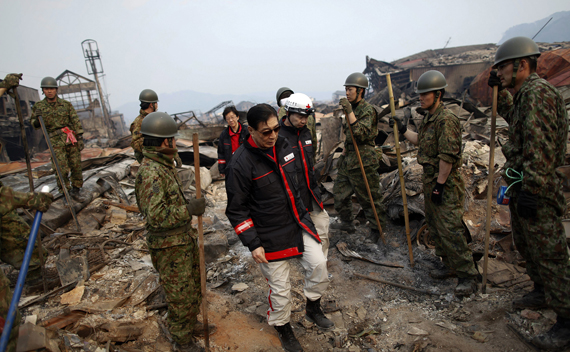Japan Begins Recovery
More on:

The impact of Japan’s deadly earthquake and tsunami is now apparent. With search and rescue personnel now reaching some of the communities in the northeastern region of Tohoku, the devastation along the eastern coast is complete. Entire villages are in ruin, roads and bridges broken and impassible, and thousands remain stranded in isolated schools and buildings where they managed to retreat in the face of the tsunami.
The human toll is tremendous. The confirmed death toll has reached 1,834, but over 15,000 remain unaccounted for three days after the Great Tohoku Earthquake. Over 450,000 have safely evacuated, but many are without water or food. Temperatures in the chilly northeast have dipped below freezing, and many are without heating or blankets. Telephone service is starting to be restored, but water and food are hard to come by. Japanese television on Monday captured heartbreaking stories of those who survived and the long lists being compiled by local shelters of those who are searching for separated family members.
Prime Minister Naoto Kan told the nation on Saturday that this was the worst crisis Japan has faced since the devastation of World War II, and asked every person in Japan to contribute to the effort to recover. The Japanese government has displayed remarkable calm in the face of this tremendous catastrophe, and from the beginning launched an all-out and comprehensive effort to organize the country in the face of catastrophe.
The search and rescue effort has been enhanced by additional Self Defense Force deployments. Over 100,000 have now been mobilized, as well as local fire and police units. Helicopters have been working non-stop to remove those stranded in the midst of this devastation. The U.S. military has added considerable airlift capability and is working to supply the Japanese military ships that have been deployed offshore. Additional emergency relief supplies have also been brought to Japan. The USAID Disaster Assistance and Response Team (DART)—including 150 personnel and 12 canines from urban search and rescue teams from Virginia and California—arrived in Japan on Sunday. As if this wasn’t enough, the Japanese government has been struggling to contain the damage incurred by the Fukushima Daiichi nuclear plant. For the first time, a state of nuclear emergency was declared, and residents were evacuated from nearby communities. The radius of evacuation was expanded on Saturday after a hydrogen explosion at Fukushima Daiichi plant’s Unit 1 reactor increased concern. Some of those evacuated revealed limited exposure to radiation. A second hydrogen explosion occurred on Monday at the Unit 3 reactor.
As of Monday, 91 countries have offered Japan assistance. The World Food Program and five other international organizations have begun to organize help as well. On Friday, President Barack Obama pledged full assistance and promised Japan that the United States would stand beside Japan through its reconstruction. U.S. Ambassador John Roos in Tokyo announced on Saturday details of Operation Tomodachi (“friend” in Japanese), including the deployment of the aircraft carrier USS Ronald Reagan as well as eight additional naval ships to waters off northeastern Japan. U.S. Forces Japan (USFJ) redeployed its military units stationed in Japan to regions where they could offer full assistance to Japan’s Self Defense Force. DART search and rescue teams will be based at Misawa Air Force Base. U.S. government nuclear experts are also working closely with the Japanese government.
In the United States, fundraising has already begun. The American Red Cross, Save the Children, and Mercy Corps (working with Peace Winds Japan) have efforts with their counterparts in Japan. The Japanese Embassy in Washington carries a list of options for those seeking to donate to the relief effort. The National Japan America Society in Washington DC, as well as Japan-America Societies around the country, are organizing to help the disaster victims.
Throughout the weekend, as the effort to organize relief gained momentum, the dignity and the calm of the Japanese people in the face of such devastation was on display across the board. Japan’s leaders, dressed in blue disaster relief uniforms, presented the scope of the disaster with clarity and calm, providing detailed descriptions of the complex stream of information becoming available from the stricken regions in the north as well as from the nuclear complex in Fukushima. Japanese television reporters supplied a comprehensive coverage on a similar range of information by providing nuclear physicists to carefully explain the details of the government’s announcements, following the growing number of displaced Japanese in the northeast, and streaming the names of those already confirmed dead.
In community after community, the Japanese people were articulate—if traumatized—about their needs and their experiences. In the face of this overwhelming shock and loss of life, the resilience and the strength of this fragile nation has been on constant display. Needless to say, the effort at reconstruction will be long, and hard. This morning the country began scheduled power cuts across much of Tokyo and its surrounding region in an effort to avoid a power failure. With many nuclear and conventional power plants offline, Japan has lost access to about 25 percent of its electricity. Transportation systems have been affected, and Tokyo commuters lined up in the hundreds at train and subway stations in an effort to make their way to work this morning.
Yet, despite the shock and devastation, the Japanese people have gone on to focus on recovery—and they will need all the help we can offer.
More on:
 Online Store
Online Store